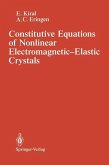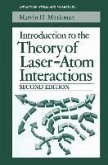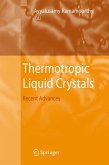This is the first comprehensive textbook on the optical properties of photonic crystals. It deals not only with the properties of the radiation modes inside the crystals but also with their peculiar optical response to external fields. A general theory of linear and nonlinear optical response is developed in a clear and detailed fashion using the Green's function method. The symmetry of the eigenmodes is treated systematically using group theory to show how it affects the optical properties of photonic crystals. Important recent developments such as the enhancement of stimulated emission, second harmonic generation, quadrature-phase squeezing, and low-threshold lasing are also treated in detail and made understandable. Numerical methods are also emphasized. Thus this book provides both an introduction for graduate and undergraduate students and also key information for researchers in this field. This second edition has been updated and includes a new chapter on superfluorescence.
Dieser Download kann aus rechtlichen Gründen nur mit Rechnungsadresse in A, B, BG, CY, CZ, D, DK, EW, E, FIN, F, GR, HR, H, IRL, I, LT, L, LR, M, NL, PL, P, R, S, SLO, SK ausgeliefert werden.
From the reviews:
"Sakoda's book is a very good theoretical introduction to PBGs [photonic bandgaps]. The writing style is exceedingly clear and the mathematical formulas are carefully explained. The straightforward presentation makes it a good choice for students, Ph.D. candidates and researchers who want to tackle the topic ... I enthusiastically recommend the book to students and researchers working in the areas of solid-state and optoelectronic devices. It would be an extremely worthwhile acquisition for any university library."
-OPTICS & PHOTONICS NEWS
From the reviews of the second edition:
"This is the first comprehensive textbook on the optical properties of photonic crystals. ... Important recent developments such as the enhancement of stimulated emission, second harmonic generation ... are also treated in detail and made understandable. ... This book provides both an introduction for graduate and undergraduate students and also key information for researchers in this field." (Zeitschrift für Kristallographie, Issue: 9-10, 2005)
"This is the first comprehensive textbook on the optical properties of photonic crystals. It deals not only with the properties of the radiation modes inside the crystals but also with their peculiar optical response to external fields. A general theory of linear and nonlinear optical response is developed in a clear and detailed fashion using Green's function method. ... This book provides both an excellent introduction for graduate and undergraduate students and also key information for researchers in this field." (Ralf Mayer, Optik, Vol. 117 (7), 2006)
"The author K. Sakoda is professor at the Nanomaterials laboratory at the National Institute for Materials Science in Japan. He wrote a second edition three years after the first on the study of photonic crystals, including a new chapter on superfluorescence. The key point is that the fundamental interaction betweenthe radiation field and matter is now controllable using photonic crystals, an invention which combines optical physics and recent microfabrication techniques. ... is well accessible to undergraduate students in physics, optics, electronics or engineering." (Physicalia Magazine, Vol. 29 (2), 2007)
"Sakoda's book is a very good theoretical introduction to PBGs [photonic bandgaps]. The writing style is exceedingly clear and the mathematical formulas are carefully explained. The straightforward presentation makes it a good choice for students, Ph.D. candidates and researchers who want to tackle the topic ... I enthusiastically recommend the book to students and researchers working in the areas of solid-state and optoelectronic devices. It would be an extremely worthwhile acquisition for any university library."
-OPTICS & PHOTONICS NEWS
From the reviews of the second edition:
"This is the first comprehensive textbook on the optical properties of photonic crystals. ... Important recent developments such as the enhancement of stimulated emission, second harmonic generation ... are also treated in detail and made understandable. ... This book provides both an introduction for graduate and undergraduate students and also key information for researchers in this field." (Zeitschrift für Kristallographie, Issue: 9-10, 2005)
"This is the first comprehensive textbook on the optical properties of photonic crystals. It deals not only with the properties of the radiation modes inside the crystals but also with their peculiar optical response to external fields. A general theory of linear and nonlinear optical response is developed in a clear and detailed fashion using Green's function method. ... This book provides both an excellent introduction for graduate and undergraduate students and also key information for researchers in this field." (Ralf Mayer, Optik, Vol. 117 (7), 2006)
"The author K. Sakoda is professor at the Nanomaterials laboratory at the National Institute for Materials Science in Japan. He wrote a second edition three years after the first on the study of photonic crystals, including a new chapter on superfluorescence. The key point is that the fundamental interaction betweenthe radiation field and matter is now controllable using photonic crystals, an invention which combines optical physics and recent microfabrication techniques. ... is well accessible to undergraduate students in physics, optics, electronics or engineering." (Physicalia Magazine, Vol. 29 (2), 2007)









